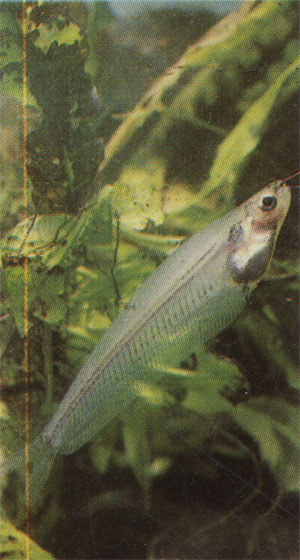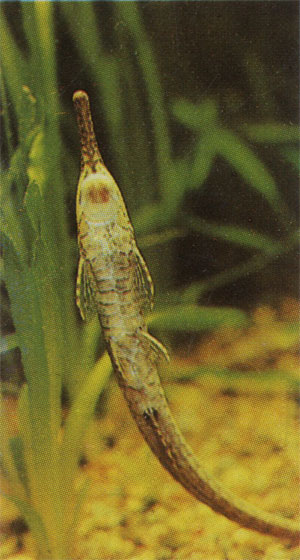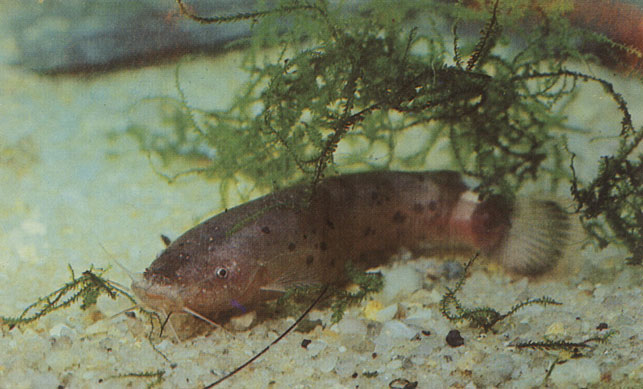
Предисловие
Под собирательным названием - сомы подразумевают свыше 2000 видов разнообразных усатых рыб из 31 семейства. Большинство их населяет пресные водоемы 5 континентов (лишь 1% - морские жители). Только в реках и озерах Южной Америки обитает около 1000 видов. Нередко тело рыб покрыто костными пластинками или защищено шипами. Благодаря вспомогательным дыхательным органам (кожному, выростам жаберной полости и т. д.) сомы нетребовательны к кислороду. Они ведут преимущественно донный образ жизни, активизируясь в вечерние и ночные часы. Обыкновенный сом (Silurus glanis) принадлежит к 5-метровым исполинам, а паразитический сомик (Vandellia cirrhosa) не бывает крупнее 2,5 см. Электрические сомы способны наносить ощутимые удары током, а косатковые, шильбовые и др. вибрациями плавников, плавательного пузыря и т. д. могут издавать звуки. Прикрепляясь к донному субстрату, с помощью присосок (ротовых, грудных и т. п.) лорикариды, сисориды и др. удерживаются на быстром течении. А слепые Satan, Trogloglanis (Ю. Америка) и Uegitglanis (Африка) обосновались глубоко под землей в пещерах и артезианских бассейнах. Есть среди них и почти совсем прозрачные стеклянные сомики (Physailia, Tandanus, Parailia и др.
В аквариумах содержат до 800 видов (в СССР около 70). Условия содержания: DH 6 - 12°, рН 6,8 - 7,5, Т 22 - 26°С, аэрация, фильтрация, подмена воды (1/10 ежедневно); аквариумы лучше с большей площадью дна; водные растения - с развитой корневой системой (Cryptocoryne, Echinodorus и т. п.); грунт - окатанный гравий 5 - 10 мм в диаметре. Стимулом к размножению служит дождевание (от нескольких дней до 1 месяца), повышение температуры воды, наличие субстрата (растительность, керамические трубки, пещерки из камней и т. п.). Созревают сомы в 1 - 3 года. Ускоряют созревание внутримышечные инъекции гипофиза (2 - 4 мг/кг) и гонадо-тропина (100 - 200 ед.). Самцы обычно стройнее самок и имеют дополнительные признаки: увеличенные плавники, кожные выросты, укрупненную голову и др. Для нереста мелких видов используют аквариумы емкостью 20 - 50 литров, для крупных 100 - 500 л. Нерест, как правило, сезонный. Многие сомы охраняют потомство: Galeichthys felis вынашивает икру во рту, Aspredo прикрепляет ее к брюшной стенке, a Trachycorystes - с внутренним оплодотворением. Инкубационный период 1 - 10 дней. Продуктивность колеблется в пределах 50 - 30000 икринок. Питаются в основном животными кормами, но есть и любители растительных обрастаний, органических остатков и т. п. Молодь выкармливают коловраткой, микрочервем, измельченным трубочником, пылеобразным яичным желтком, печенью и т. п. В аквариуме живут от 3 до 25 лет.
The generic name of Catfishes covers over 2,000 species of barbeled fishes from 31 families. The majority of them are to be found in fresh waters of the five continents, "sea-dwellers" account only for 1 per cent. The rivers and lakes of South America alone accommodate about 1,000 species. Quite often the body of these fishes is covered with bony plates or protected by thorns. Owing to accessory air-breathing organs (extensions of the gill-chamber, etc) Catfishers are undemanding as regards oxygen. They dwell mainly on the bottom, being more active at night. They vary from 5-metre-long giants (Silurus glanis) to 2.5 cm parasitic catfish (Vandellia cirrhosa). Electric catfishes can produce powerful discharges, while bagrid and schilbeid catfishes can emit sounds by fin vibration or by using their swimming bladder, etc. Clinging to the bottom with the help of their suckingmouths or pectoral suckers, loricariid and sisorid catfishes can resist a strong current, while blind Satan, Trogloglanis (South America), Uegitglanis (Africa) settle down deep in the underground caverns and artesian wells. There are also almost translucent glass catfishes (Physailia, Tanaanus, Parailia, etc).
Up to 800 species are kept in captivity (about 70 species in the USSR). Care: DH 6-12, pH 6.8-7.5, T 22-26°C, aeration, filtration, 1/10 of the water should be changed daily. An aquarium with a large square bottom is preferable; aquatic plants with strong rootage (Cryptocoryne, Echinodorus, etc); substratum - rolled gravel 5 to 10 mm in diameter. The spawning may be stimulated by artificial raining (from some days to one month), raising of the temperature, substratum availability (vegetation, ceramic tubes, stony caves, etc). The majority of Catfishes reach sexual maturity at 1 to 3 years. Sexual maturity may be accelerated by intramuscular injections of hypophysis (2 - 4 mg/kg) and gonadotropin (100 - 200 I. U.). As a rule males are slenderer than females and they possess accessory features: enlarged fins, skin extensions, large head, etc. 20 - 50 1 aquaria are used to breed small species, while the large ones are bred in 100 - 500 1 tanks. Spawning as a rule is seasonal. Many Catfishes actively protect their progeniture: Galeichthys felis breeds the eggs in its mouth, Aspredo attaches the eggs to the lower part of its belly, Trachycorystes - have interior insemination. The incubation period varies from 1 to 10 days. Fecundity up to 50 - 30,000 eggs. Catfishes prefer mainly live food of all kinds", but there are some vegetarians. The young should be fed with rotifers, "mikro" worms, chopped Tubifex, powdered yolk, liver, etc. Life span in aquaria is 3 to 25 years.
Bajo el nombre generico de siluros se entienden mas de 2 000 especies de peces con barbillas de 31 familias, cuya mayoria pueblan aguas dulces de cinco continentes у solo un por ciento de ellos son habitantes del mar. Tan solo en los rios у lagos de America del Sur se presentan cerca de mil especies de esta indole.
Con frecuencia, el cuerpo de los siluros viene cubierto de placas oseas о pertrechado de denticulos. Mayormente repo-san en el fondo - lo que mas caracteriza su modo de existencia - у se activan al anochecer. El siluro comiin (Silurus glanis) es la especie de gigantes de 5 metros de largo, mientras que el silurillo de vida parasitaria, Vandellia cirrhosa, nunca pasa de 2,5 centimetros. Los peces de la unica especie del genero Malapterurus electricus son capaces de producir sensibles descargas electricas, у los de las familias Bagridae у Schilbeidae у otras producen sonidos al hacer vibrar las aletas, vejiga natatoria, etc. Sujetandose con unas ventosas (bucales, pectorales, etc) al substrato dil fondo, los peces de las familias Loricariidae, Sisoriidae у otras se resisten a corrien-tes rapidas. Los peces ciegos Satan, Trogloglanis (Sudamerica) у Uegitglanis (Africa) habitan las aguas de cavernas о cuencas subterraneas. Entre estas especies hay pececillos casi trans-parentes (Physailia, Tandanus, Parailia у otros). En acuarios se crian peces de casi 800 especies (alrededor de 70, en la URSS). Las condiciones vitales son: DH = 6 - 12°; pH = 6,8 - 7,5; T = 22 - 26° C; aireacion, filtracion у reno-vacion diaria (1/10 del volumen) del agua. Son preferentes acuarios de mayor superficie del fondo, plantas acuaticas de fuertes raices (Cryptocoryne, Echinodorus, etc.); el fondo, de guijos rodados de 5 a 10 mm de diametro. La reproduction de los peces es estimulada con una lluvia artificial (de unos dias a un mes), elevation de la temperature del agua, el substrato apropiado (plantas acuaticas, tubitos ceramicos, grutas de piedras, etc.). Los individuos pubescen entre uno у tres anos. Aceleran el proceso de pubescencia inyecciones intramusculares del extracto de hipofisis (2 - 4 mg/kg), о gonadotropina (100-200 unidades). Los machos suelen ser mas garbosos que las hembras, ostentando, ademas, caracteres exclusivos de su sexo: aletas de mayor tamano, excrecencias dermicas, cabeza mas grande, etc. Para el desove de especies menudas se utilizan acuarios de 20 a 50 litros, у para mayores, de 100 a 500 litros. La muga suele ser estacional. Muchas de las especies tratadas protegen activamente su prole: las hembras de Galeichthys felis guardan los huevos fecundados en la boca, las Aspredo los pegan a su vientre у hasta que las hembras Trachycorystes se distinguen por la fecundation interior. El periodo embrionario de los huevos varia entre uno у diez dias. La capacidad prolifica es de 50 a 30 000 huevos. El alimento i'S mayormente de naturaleza animal, pero hay tambien entre estos peces amigos de consumir sedimentos organicos, flora mimiscula del substrato, etc. Los alevines se crian con roti-feros, microlombrices, tubicolas desmenuzados, la yema pul-verizada del huevo de gallina, higado, etc.

Сомы

Сомы

Сомы
|
ПОИСК:
|
© Злыгостев Алексей Сергеевич, 2001-2019
При использовании материалов сайта активная ссылка обязательна:
http://aquariumlib.ru/ 'Библиотека по аквариумистике'
При использовании материалов сайта активная ссылка обязательна:
http://aquariumlib.ru/ 'Библиотека по аквариумистике'